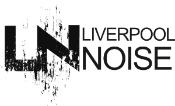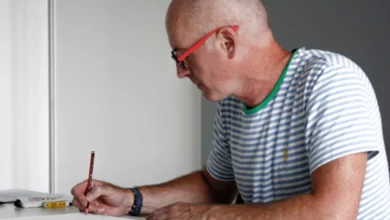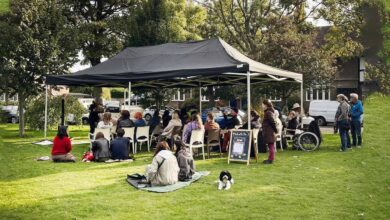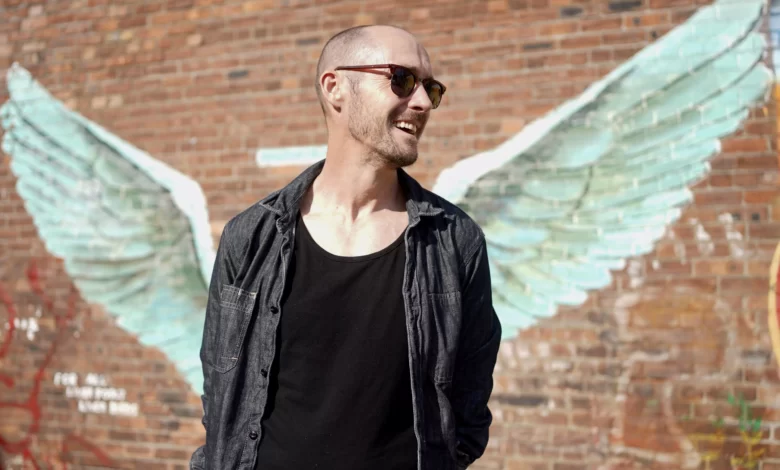
Creative Spotlight: In Conversation – Paul Curtis
The Art of the City: Paul Curtis on Murals, Milestones, and Merseyside Pride
If you’ve wandered the streets of Liverpool with your eyes open, chances are you’ve encountered the vivid, soul-stirring work of Paul Curtis. From the now-iconic For All Liverpool’s Liver Birds wings on Jamaica Street to a growing portfolio of murals that speak to the heart of the city. Once a geologist, now a painter of walls and chronicler of culture, Curtis captures moments of local identity with a striking blend of realism, nostalgia and Scouse humour. His work doesn’t just decorate – it reverberates, offering passers-by moments of recognition, reflection, and pride. In a city that values story and spirit, Paul Curtis has found his canvas in the bricks and stories that line our streets.
Steve Kinrade caught up with Paul as part of Liverpool Noise’s 2025 Monthly Creative Spotlight series, where he takes centre stage as July’s featured artist. We talked brushes, backdrops, and the beauty of public reaction…
Your For All Liverpool’s Liver Birds was your first public piece and became a huge success. Looking back, did you ever anticipate such a massive reaction?
Paul Curtis: My hope was that people would notice it, but the scale of the reaction completely took me by surprise. I wasn’t prepared for that much publicity so early on in my art career and it was actually a little bit scary.
One of the reasons I painted it was to me was allow me to become a professional artist. However, at the time I’d only just started, and that level of reaction meant it was a bit like being thrown in the deep end. Obviously I’m grateful as it achieved the goal I wanted it to, but I was feeling a little exposed as I was a so green as a street artist.
You have mentioned that For All Liverpool’s Liver Birds felt like a “last throw of the dice”. What were the motivating factors in order to take that leap of faith into the art world?
PC: Basically, I was trying to work out how to make a success as a muralist more than a street artist, but I was really struggling it was very difficult to get any sort of decent work. I was getting the odd job here and there, getting way below minimum wage, and I was at the point of throwing the towel in. If the wings had not got as much attention as they did, then for sure, I wouldn’t be a professional artist.
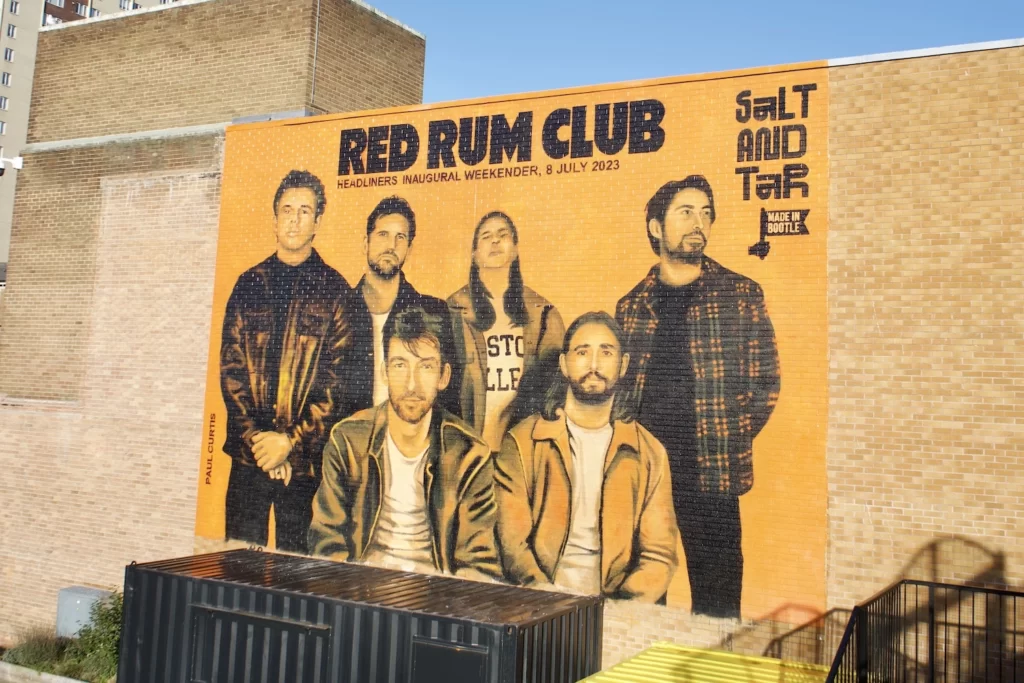
Reflecting on your transition from geology to professional artist after the 2014 oil crash, what key lessons in resilience and creativity have you taken from that journey over the past eleven years?
PC: I guess it’s the same sort of lessons that you often hear from other people who have been through redundancy and gone it alone. It’s about being able to take rejection and use it as a motivating factor. Believe in yourself – this may not come immediately but over time you build that confidence. It’s about learning from your mistakes, companies don’t like people making mistakes and nobody wants to make mistakes but when you represent yourself and make mistakes, you learn to see them as valuable lessons.
Do you have any particular artistic influences that have shaped your approach to your creative process?
PC: I wouldn’t say that I have one specific artistic influence. If you look at my artwork, it’s very varied and I am always open to different styles. I keep an open mind and I look everywhere for influences not just the more traditional places such as paintings in a gallery. I’m always looking things such as movie scenes, advertising, design techniques on the High Street even things like video games, which is probably an underrated art form.
You created mural work for Danny Boyle’s Beatles-inspired film Yesterday. What was the experience like working on a film set and contributing to such a distinctive project?
PC: It was great. I am a massive fan of Danny Boyle so I was quite excited to me him in person. They say that it can be bad to meet your heroes but actually he was one of the nicest people I’ve met. He took time to speak to me on set and even come back to ask if he could have a photo with me. I believe he did this because he could tell I wanted a photo with him but was too shy to ask. He’d read the situation well!
Did you encounter any creative tension in collaborating as part of a team, as opposed to having full control over your artistic vision?
PC: The vast majority of my work is commissioned so it’s rare that I have complete artistic licence. I have to work within the client’s demands. It’s my job to make it look the best I can. I will advise when I think the client’s brief negatively impacts the look of the artwork. Sometimes they will take my advice on board, sometimes they don’t. When it comes to physically painting, I always prefer to do it completely by myself. It’s just preference I find it makes for a more cohesive artwork.
In 2020, BBC North West Tonight featured your street art and its impact on the local community. Since then, what positive changes or stories have you observed as a result of your public art?
PC: For the main part street art has positive effects on local areas – there are dozens of news and magazine articles that talk about its positive impact and how it can improve an area. However, it depends on the work and its quality and it depends on the community. It tends to be communities that have been neglected that appreciate the artwork more. It can really be a source of pride for an area in some cases.
Conversely, are there any challenges or downsides to creating art in public spaces from your perspective?
PC: The main problem with public art is that your audience is the whole population. This may sound like a massive positive (and it is in some ways) t, but the reality is that 100% of the population does not share the same tastes in art. There is nothing in the world that is 100% liked by everyone therefore statistically, there will always be some people who don’t like a painting. I try to keep my work as pleasing to the majority as far as possible but in doing so, I have to accept that’s some people may want it to be more cutting edge whereas others may want to be more traditional.
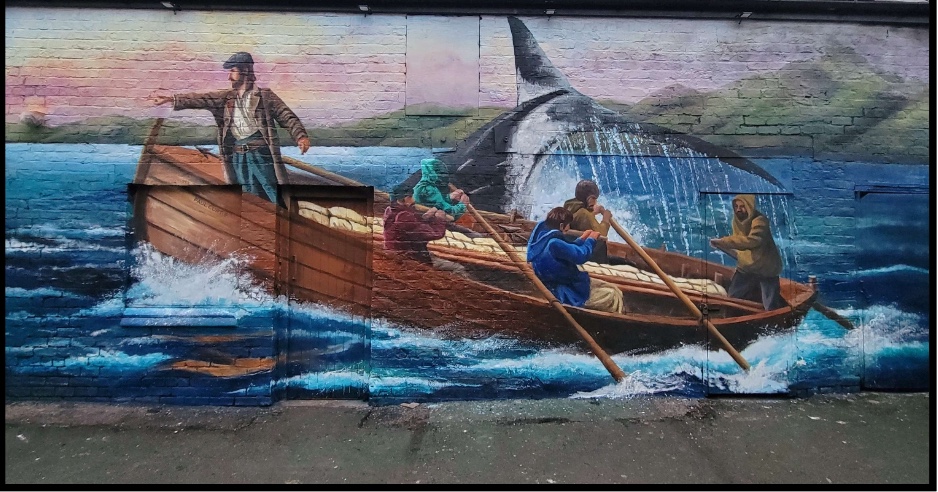
I would now like to talk about a specific work. The Whalers has fascinated me since it was created. The Jawbone Tavern has strong ties to Bootle’s maritime past, especially with whaling crews. How did this local history shape the concept and storytelling of the mural?
PC: So the Jawbone Tavern Has been a pub since 1852 the story goes that a lot of the whalers who docked at Bootle docks wood visit the Jawbone, it was their local essentially. At one time the entrance to the pub was actually a whale’s jawbone, hence the name, but I’m not sure what happened to that.The owner and myself decided we wanted to recognise the link between the pub and the whalers. Thankfully we no longer hunt whales – but it was a big part of the Port of Liverpool’s history.
How important was the location itself — the side of the pub — influencing the scale, composition, or subject matter of the work?
PC: I don’t really get to choose the locations very often – I generally get asked to paint to improve unloved walls in specific locations. So in this particular case, they wanted to change a pub yard into a nice beer garden. The wall the mural is now on was pretty unloved and my task was to improve it. When I do a mural I like to use much of the wall space as possible as I find this gives the painting most impact.
There’s a real sense of drama and tension in the scene: what mood were you aiming to evoke, especially considering the mural’s historical setting and pub culture context?
PC: It’s a real historical piece related to the story the Jawbone Tavern and Bootle. Given the subject matter, I saw it as a chance to include some drama as well. It’s always a good idea to include some sense of movement in a mural and equally, I like to do these historical pieces. I find that people have a real affinity with pieces that evoke scenes based on history. For example, look at the Birkenhead Drill and Sailing Through Time murals I did in Birkenhead and Bootle respectively.
From the textures of the waves to the sheen on the whale’s body, the detail is remarkable! What were the biggest technical challenges in achieving that realism on a brick façade?
PC: The biggest difficulty for me painting this was the age of the bricks and the architectural features on the building (there are many windows/doors) – this is definitely not a smooth canvas and you’re absolutely right that it was a very difficult surface to work with – especially including details like the hands and the faces. The other major challenge I had was the weather. It was one of the coldest weeks we’ve had this year so every 30 minutes or so I would have to put my hands under the hand dryer in the bathroom to get the blood back to my fingers!
Given the Jawbone’s long-standing role in the Bootle community, did you have any conversations with locals during the creation process? What kind of reactions or stories did they share?
PC: Painting was done during the conversion of the bin yard into a beer garden and as such I was working away from the customers so didn’t get much chance to interact. However, as I have since painted a second mural (Two Whales) at the Jawbone, I have had a chance to speak to some of the regular. They seem to really like the mural and take some ownership of it and moreover, they enjoy seeing the overall improvements ongoing to their pub.
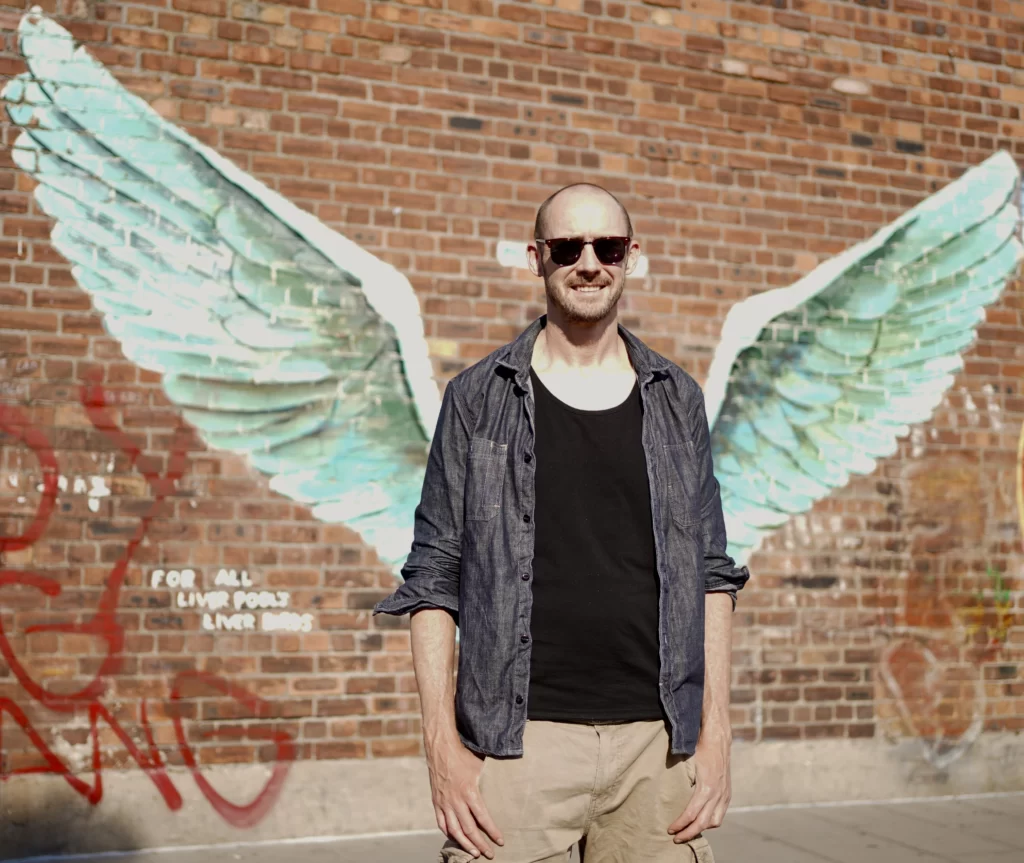
This piece clearly connects deeply with Liverpool’s dockside identity. How does it sit within your wider body of work, and what did you take away personally from painting it?
PC: I am a bit of a history buff so I love being asked to do pieces that link to our own history. One of the best things about my job is the variation in work and projects. I love getting the chance to research something new and this artwork that led to me finding out about a topic Liverpool’s history which did not know too much about!
Being added to Liverpool’s Wall of Fame at the Museum of Liverpool is a significant achievement. What are your thoughts on having your work permanently recognized in this way?
PC: Well I was surprised to be honest, mainly because I was looking at the other people who were on the wall, I couldn’t believe I was in amongst them! I did not know I was to be included so it was a really nice moment, when I saw for myself that I was on the wall. To be recognised by your own city is a massive honour – no doubt about it.
With your artwork now so prominent across Merseyside and beyond, what are your future artistic aspirations and dream projects for 2025 and the future?
PC: It would be nice to continue to grow particularly further afield. I love seeing Scousers do well nationally I think when that happens, it reflects really well on the city. That said, undoubtably I also want to achieve this ambition for my own goals also. Who knows? – for now all I can do is keep on painting what happens!
Paul Curtis was in conversation with Steve Kinrade.
